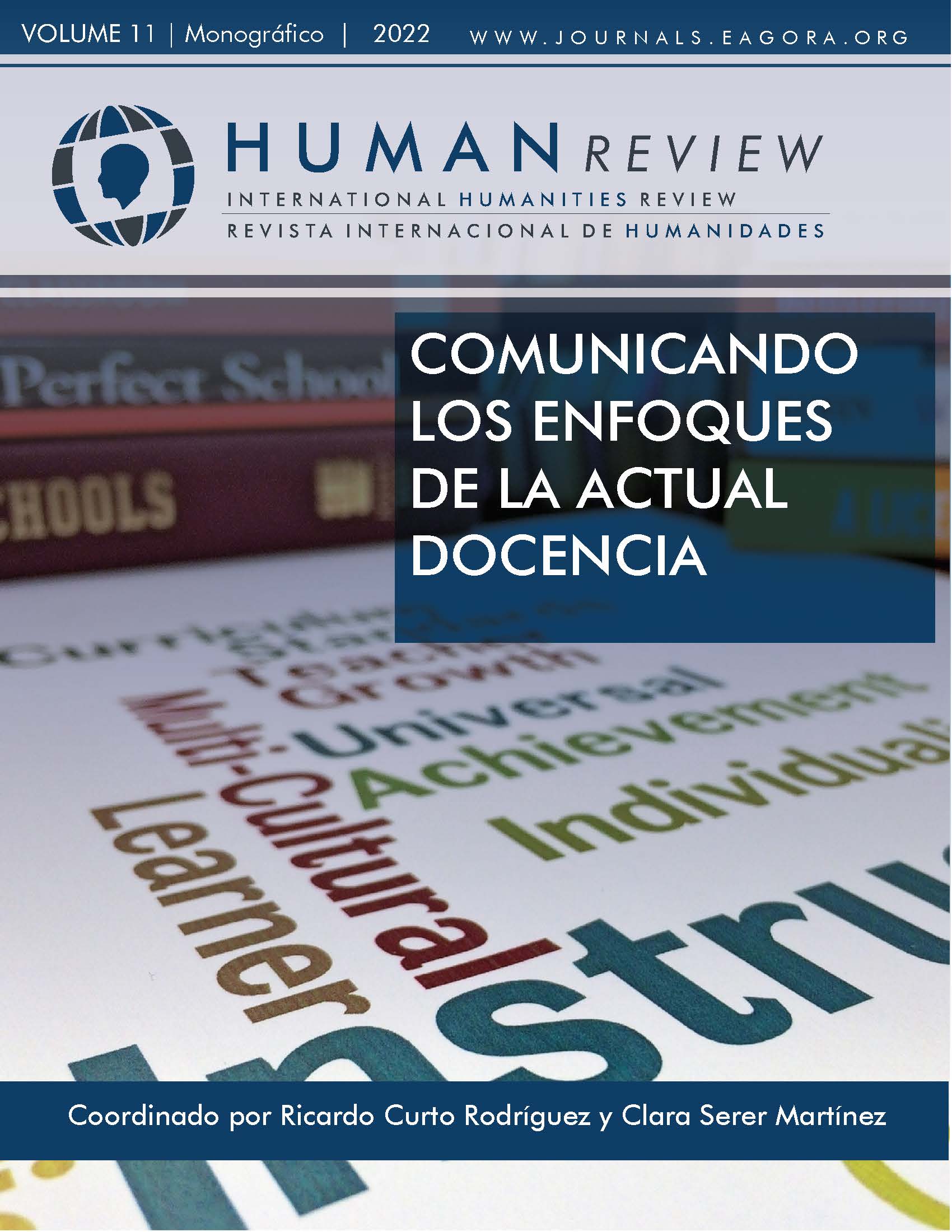La interacción entre pares y el input escrito
Influencia del input escrito en las interacciones orales de aprendientes de alemán como lengua extranjera
DOI:
https://doi.org/10.37467/revhuman.v11.3866Palavras-chave:
Enseñanza de lenguas extranjeras, Adquisición de lenguas extranjeras, Investigación en el aula, Interacción entre pares, Modalidad de input, Educación, Estrategias pedagógicasResumo
El estudio presente investigó la influencia del input escrito en las interacciones orales entre pares en un aula de alemán como lengua extranjera. Los aprendientes participaron en seis actividades de interacción en el aula. Un grupo de catorce aprendientes fue expuesto a input oral durante las actividades y el otro grupo de catorce aprendientes aparte del input oral también recibió input escrito. Las interacciones orales fueron grabadas en audio y transcritas para analizar la frecuencia y la naturaleza de los episodios relacionados con la lengua (ERL). Los resultados sugieren que el input escrito influye en las interacciones orales.
Referências
Adams, R. & Oliver, R. (2019). Teaching through peer interaction. Routledge. DOI: https://doi.org/10.4324/9781315115696
Adams, R. & Ross-Feldman, L. (2008). Does writing influence learner attention to form? En D. Belcher, y A. Hirvela (Eds.), The oral-literate connection: Perspectives on L2 speaking, writing, and other media interactions (pp. 243-265). The University of Michigan Press.
Amo-García, N. (2021). The Impact of Task Modality on Collaborative Tasks in English Foreign Language Contexts: Language-Related Episodes [Tesis doctoral]. Universidad Autónoma de Barcelona. https://ddd.uab.cat/pub/tfg/2021/249145/AmoGarciaNatalia_TFG2021.pdf
Choi, H. & Iwashita, N. (2016). Interactional behaviours of low-proficiency learners in small group work: Pedagogical potential and research agenda. En M. Sato, y S. Ballinger (Eds.), Peer interaction and second language learning: Pedagogical potential and research agenda (pp. 113-134). John Benjamins. https://doi.org/10.1075/lllt.45.05cho DOI: https://doi.org/10.1075/lllt.45.05cho
Consejo de Europa (2020). Marco común europeo de referencia para las lenguas: aprendizaje, enseñanza, evaluación. Volumen complementario. Servicio de publicaciones del Consejo de Europa.
Dörnyei, Z. (2007). Research methods in applied linguistics: Quantitative, qualitative and mixed methodologies. Oxford University Press.
Ellis, R. (2015). Understanding second language acquisition (2ª ed.). Oxford University Press.
García-Mayo, M. P. & Azkarai, A. (2016). EFL task-based interaction: Does task modality impact on language-related episodes? En M. Sato, y S. Ballinger (Eds.), Peer interaction and second language learning: Pedagogical potential and research agenda (pp. 241-266). John Benjamins. https://doi.org/10.1075/lllt.45.10gar DOI: https://doi.org/10.1075/lllt.45.10gar
Gass, S. M., Mackey, A. & Ross-Feldman, L. (2005). Task-based interactions in classroom and laboratory settings. Language Learning, 55(4), 575-611. https://doi.org/10.1111/j.0023-8333.2005.00318.x DOI: https://doi.org/10.1111/j.0023-8333.2005.00318.x
Kim, Y. (2008). The contribution of collaborative and individual tasks to the acquisition of L2 vocabulary. The Modern Language Journal, 92(1), 114-130. https://doi.org/10.1111/j.1540-4781.2008.00690.x DOI: https://doi.org/10.1111/j.1540-4781.2008.00690.x
Kim, Y. (2012). Task complexity, learning opportunities, and Korean EFL learners’ question development. Studies in Second Language Acquisition, 34(4), 627-658. https://doi.org/10.1017/S0272263112000368 DOI: https://doi.org/10.1017/S0272263112000368
Kim, Y. (2015). The role of tasks as vehicles for language learning in classroom interaction. En N. Markee (Ed.), The handbook of classroom discourse and interaction (pp. 163-181). Wiley-Blackwell. https://doi.org/10.1002/9781118531242.ch10 DOI: https://doi.org/10.1002/9781118531242.ch10
Kirchhoff, N. (2021a). Input modality in oral peer interactions: instructional conditions in the German as a foreign language classroom [Tesis doctoral inédita]. Universidad de Cádiz.
Kirchhoff, N. (2021b). The impact of input modality on collaborative peer interaction. En J. J. Gázquez-Linares, M.M. Molero-Jurado, A. Martos-Martínez, A. B. Barragán-Martín, M. M. Simón-Márquez, M. Sisto, R.M.del Pino-Salvador, y B. M. Tortosa-Martínez (Comps.), Innovación docente e investigación en arte yhumanidades: Avanzando en el proceso de enseñanza-aprendizaje (pp. 593-604). Dykinson, S. L.
Loewen, S. (2020). Introduction to instructed second language acquisition (2ª ed.). Routledge. DOI: https://doi.org/10.4324/9781315616797
Loewen, S. y Sato, M. (2018). Interaction and instructed second language acquisition. Language Teaching, 51(3), 285-329. https://doi.org/10.1017/S0261444818000125 DOI: https://doi.org/10.1017/S0261444818000125
Philp, J. J., Adams, R. & Iwashita, N. (2014). Peer interaction and second language learning. Routledge. DOI: https://doi.org/10.4324/9780203551349
Sato, M. y Ballinger, S. (Eds.) (2016). Peer interaction and second language learning: Pedagogical potential and research agenda. John Benjamins. DOI: https://doi.org/10.1075/lllt.45
Storch, N. & Aldosari, A. (2013). Pairing learners in pair work activity. Language Teaching Research, 17(1), 1-18. https://doi.org/10.1177/1362168812457530 DOI: https://doi.org/10.1177/1362168812457530
Suzuki, W. & Storch, N. (2020). Introduction. En W. Suzuki, y N. Storch (Eds.), Languaging in Language Learning and Teaching: A collection of empirical studies (pp. 1-16). John Benjamins. https://doi.org/10.1075/lllt.55.int DOI: https://doi.org/10.1075/lllt.55
Niu, R. (2009). Effect of task-inherent production modes on EFL learners’ focus on form. Language Awareness, 18(3-4), 384-402. https://doi.org/10.1080/09658410903197256 DOI: https://doi.org/10.1080/09658410903197256
Ziegler, N. & Bryfonski, L. (2018). Interaction-Driven L2 Learning: Advanced learners. En P. Malovrh, y A. Benati (Eds.), The Handbook of Advanced Proficiency in Second Language Acquisition (pp. 94-113). Wiley-Blackwell. https://doi.org/10.1002/9781119261650.ch6 DOI: https://doi.org/10.1002/9781119261650.ch6
Referencias de imágenes
Andi O. (n.d.). Trip to Prague [Photograph]. FreeImages. https://www.freeimages.com/es/photo/trip-to-prague-1217831
Eisenberg, J. D. (2004). Amusement Park [Photograph]. FreeImages. https://www.freeimages.com/es/photo/amusement-park-1478764
Huszár, M. (2004). Tough at the Top [Photograph]. FreeImages. https://www.freeimages.com/es/photo/tough-at-the-top-1402244
Kucinski, P. (n.d.). Trip [Photograph]. FreeImages. https://www.freeimages.com/es/photo/trip-1497498
Navarro, J. L. (2006). Zoo Elephants [Photograph]. FreeImages. https://www.freeimages.com/es/photo/zoo-elephants-1389904
Torterolo, M. (2005). Day of Beach [Photograph]. FreeImages. https://www.freeimages.com/es/photo/day-of-beach-1407654
Downloads
Publicado
Como Citar
Edição
Seção
Licença
Os autores/as que publicam nesta revista concordam com os seguintes termos:
- Os autores/as terão os direitos morais do trabalho e cederão para a revista os direitos comerciais.
- Um ano após a sua publicação, a versão do editor estará em acesso aberto no site da editora, mas a revista manterá o copyright da obra.
- No caso dos autores desejarem asignar uma licença aberta Creative Commons (CC), poderão a solicitar escrevendo a publishing@eagora.org.









